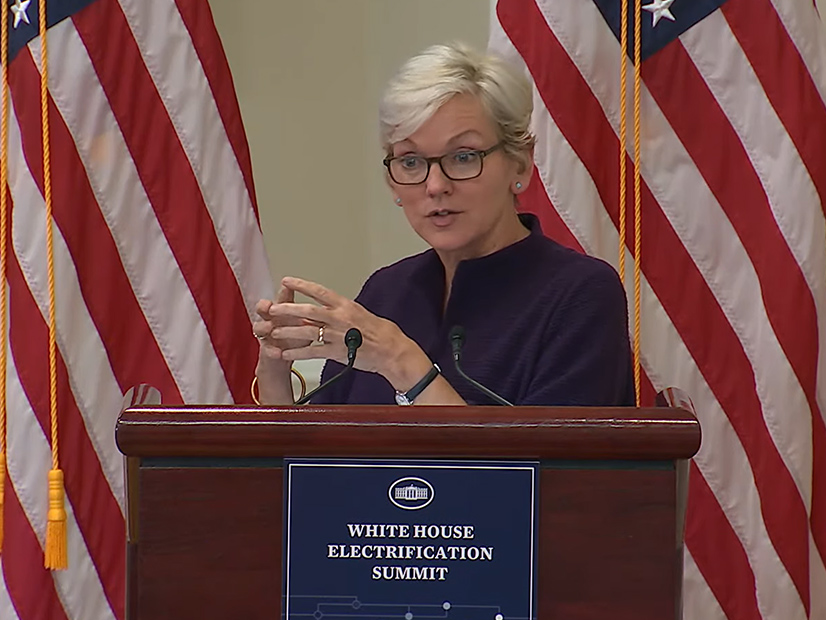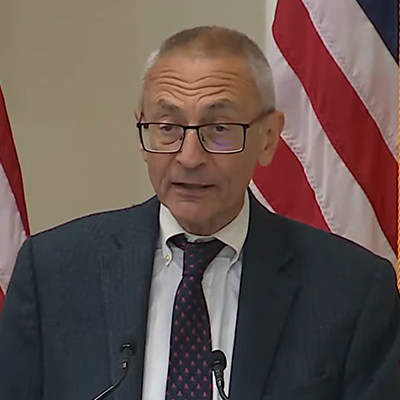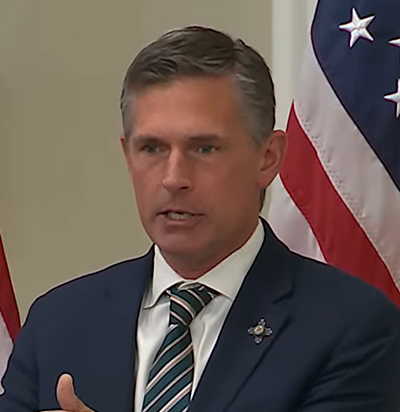
 Arati Prabhakar, White House Office of Science and Technology Policy Director | The White House
Arati Prabhakar, White House Office of Science and Technology Policy Director | The White House
Arati Prabhakar, director of the White House Office of Science and Technology Policy, opened the Biden administration’s Electrification Summit on Wednesday with a daunting but essentially hopeful vision.
Reaching President Biden’s goal of net-zero emissions economy-wide by 2050 will require a threefold increase in the rate of expanding the grid and electrifying transportation and buildings, she said. “On the one hand, we’re scaling deployment faster than we have ever done before in ways that, it almost scrapes the skin off your teeth,” she said. “At the same time … we’re going to have to scale much farther and much faster over an extended period of time. …
“That is a task that is going to require not just new innovation, but actually new forms of innovation because the kinds of challenges that are ahead of us are deeply systematic challenges … [requiring] systems innovation,” she said.
“It’s going to [require] a grid that can grow at triple the rate we’ve been growing at and handle … very rapidly changing sources and loads.”
With the home electrification tax credits and rebates in the Inflation Reduction Act scheduled to go into effect on Jan. 1, the summit was clearly the administration’s kick-off for a cross-agency, cross-industry push to promote the benefits of electrification and raise awareness of the financial support available to homeowners in the IRA.
The administration will be putting out “detailed guidance to help Americans understand how to take advantage of these new tax credits and rebates and loan programs” in a few days, said John Podesta, Biden’s senior adviser for green energy innovation and implementation.
 John Podesta, special adviser for green energy innovation and implementation | The White House
John Podesta, special adviser for green energy innovation and implementation | The White House
The administration will also be enlisting the help of labor and industry, Podesta said. “We need every American hearing from the person selling them a car or their electrician or their home contractor or their favorite employee at their local retailer about the opportunity to save money and get money back on clean technologies,” he said.
Energy Secretary Jennifer Granholm announced a trio of new initiatives aimed at building momentum, improving technologies and cutting costs for home and industrial building electrification.
The new Buildings Energy Efficiency Frontiers and Innovation Technologies program will provide $45 million in funding to “research and develop high-impact, cost-effective technologies and building retrofit practices that will reduce carbon emissions, improve flexibility and resilience, and lower energy costs,” according to a press release from the Department of Energy. The initiative is targeting innovations in air conditioning; space heating; water heating; thermal and battery storage; plug loads and lighting; and the building envelope, DOE said.
Granholm also announced the launch of the American-made Equitable and Affordable Solutions to Electrification Prize, which will offer “$2.4 million in cash prizes and technical assistance vouchers to innovators who can help simplify the electrification processes for contractors and implementers. The prize aims to make the process faster and more affordable for homeowners across diverse communities and all housing types,” the DOE said.
The third initiative, the Onsite Energy Technical Assistance Partnership program, will help “industrial facilities add more clean energy onsite to get them closer to electrification,” Granholm said.
With an anticipated $23 million in funding, the program will create “a regional network of technical assistance providers to help facilities across the nation integrate the latest onsite energy technologies, including battery storage, combined heat and power, district energy, geothermal, industrial heat pumps, renewable fuels, solar photovoltaics, solar thermal, thermal storage and wind power,” a DOE announcement said.
‘Friction Points’
Electrification of housing is critical to reducing greenhouse gas emissions. For example, according to figures from the University of California, Davis, residential energy use accounts for 20% of U.S. GHG emissions.
The IRA contains a range of rebates and credits for home electrification and energy efficiency. Rebates for heat pumps range from $2,000 to $8,000, depending on household incomes. The law also contains a 30% tax credit — up to $1,200 per taxpayer — for home efficiency upgrades, such as installing insulation or more efficient windows and doors.
The Infrastructure Investment and Jobs Act also provides increased funding for the DOE’s Weatherization Assistance program — $25 million per year through 2025 — which targets low-income homeowners.
But in many cases, states will be administering these funds, and state officials have been waiting for guidelines from the administration to help them set up their programs. Older homes in low-income neighborhoods may also need basic home repairs before they can qualify for energy efficiency funds, according to state officials and community advocates. (See PNNL: ‘Households Do Not Make Rational Decisions’ on EE Upgrades.)
 Brenda Mallory, Council on Environmental Quality | The White House
Brenda Mallory, Council on Environmental Quality | The White House
Brenda Mallory, chair of the Council on Environmental Quality, cautioned that electrification plans must protect and include “everyone, from workers to students to seniors who have been exposed to environmental hazards for decades.”
“That means not only dealing with people who currently have electricity and we’re making it better, but also giving access to people who don’t have electricity,” Mallory said. “The voices of communities who have the most to lose but the most to gain [must be] at the center of the conversation in designing the implementation strategy” for electrification.
Sen. Martin Heinrich (D-N.M.), who helped start an Electrification Caucus in Congress, agreed that one of the challenges ahead will be getting “the friction points out of implementation,” so that people can access the home electrification opportunities “quickly and seamlessly.”
 Sen. Martin Heinrich (D-N.M.) | The White House
Sen. Martin Heinrich (D-N.M.) | The White House
Citing his own experience with installing an air source heat pump water heater in his home, Heinrich recalled that his plumber had never seen the equipment before. “He showed up and was like, ‘I don’t know what to do with this,” Heinrich said. “But now he does,” and he and other contractors are installing heat pumps “one after the other.”
Such experiences could be “an enormous game changer for how a lot of this country is going to view this transition,” Heinrich said.
National Climate Adviser Ali Zaidi closed the conference by coming back to the deep changes that electrification will trigger in the U.S. energy system and the question of “who is going to benefit” from electrification.
“When we talk about climate change and climate action, I think it’s a conversation about power,” Zaidi said. “I don’t mean electricity. I mean, who will literally have the power in this moment of transformation in our economy? Who will own the substation assets? Will our utilities step up in a way that returns power to consumers who want to save energy, who want to generate energy and sell that energy onto the grid?”
While recognizing the role of utilities in cutting power sector emissions, Zaidi said, “Now we have to embrace the power of distributed technologies, and we got to do it in a way, again, that reinforces the workforce that we’re going to need to go the distance.”

